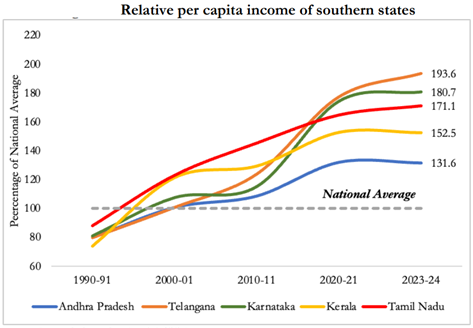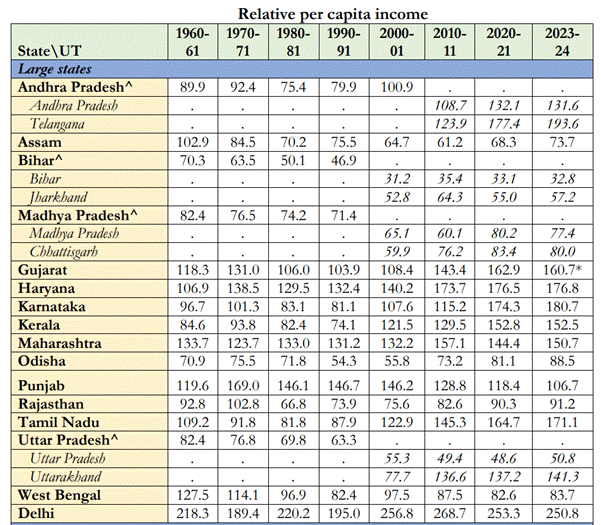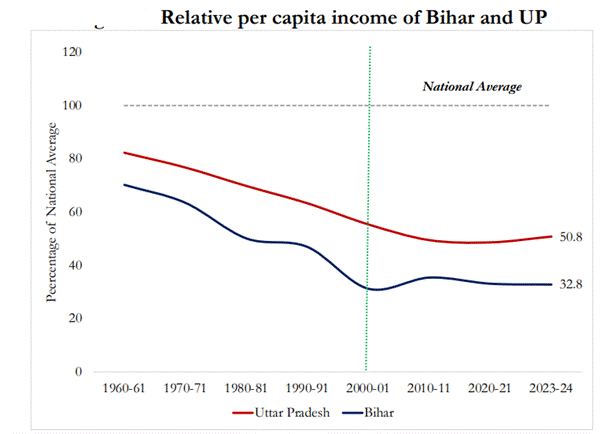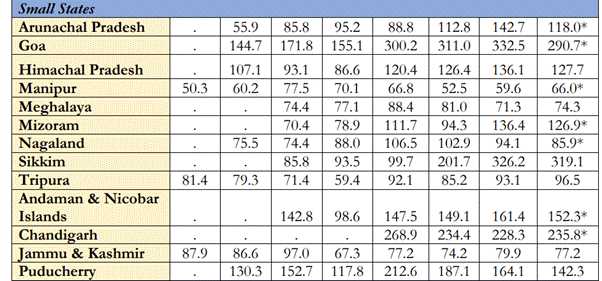PREVIOUS
Indian states growth after 1991 Part - 03
Indian states growth after 1991 Part - 03
(இதன் தமிழ் வடிவத்திற்கு இங்கே சொடுக்கவும்)
Economic Performance and Per Capita Income: Southern States
- The southern states of India have emerged as top performers in terms of per capita income since the 1990s.
- This growth has been facilitated by robust economic policies and significant contributions from various sectors.
Per Capita Income Trends in Southern States
Historical Context
- 1990-91 Baseline: In 1990-91, all southern states including Andhra Pradesh, Telangana, Karnataka, Kerala, and Tamil Nadu had per capita incomes below the national average, resulting in relative per capita incomes of less than 100.

Post-Liberalization Growth
- Surpassing the National Average: Within the first decade following economic liberalization, the relative per capita income of each southern state surpassed the national average and continued to rise rapidly.
Current Per Capita Income
- Telangana: Currently, the average income level in Telangana is 193.6% of the national average, reflecting its significant economic growth post-bifurcation.
- Karnataka: With a relative per capita income of 181% of the national average, Karnataka ranks among the top performers.
- Tamil Nadu: The state's per capita income stands at 171% of the national average, showcasing robust economic health.
- Kerala: Kerala’s per capita income has increased to 152% of the national average in 2023-24.

- It is important to note that this figure might underestimate the actual income level due to the state being a major receiver of remittances since 1991.
- Andhra Pradesh: After bifurcation, Andhra Pradesh’s relative per capita income is now at 131.6%, indicating slower growth compared to Telangana.
- Bihar's economic performance has been notably poor, consistently registering the lowest per capita income in India.
- Despite some recent stabilization, the state faces significant challenges in improving its economic standing.
Per Capita Income Trends
Historical Context
- Initial Status: In 1960-61, undivided Bihar had the lowest relative per capita income at 70.3% of the national average.
- Decline: This figure deteriorated sharply over the following decades, reaching a low of just 31.2% by 2000-01, coinciding with the bifurcation of the state.
Recent Developments
- Post-Bifurcation Growth: Since the 2000s, Bihar has seen its per capita income growth slightly exceed or match the national average.
- However, this has not translated into significant improvements in relative per capita income levels.
- Stabilization: After a decade of modest improvement, Bihar's relative per capita income increased from 31.2% in 2000-01 to 35.4% by 2010-11.
- Currently, it hovers around 33%, indicating minimal progress.
- Current Standing: This means that the average person in Bihar has an income level 77% lower than that of the average Indian.
Remittances and Economic Context
- Role of Remittances: Although remittances can enhance household incomes, the significant disparity in per capita income underscores persistent economic difficulties.
- Divergence from National Average: This trend represents a significant divergence in per capita income levels compared to the national average, marking a concerning development for the state.
Economic Performance and Per Capita Income: Uttar Pradesh, Madhya Pradesh, and Rajasthan
- The economic trajectories of Uttar Pradesh, Madhya Pradesh, and Rajasthan highlight varying degrees of progress and challenges in relative per capita income over the decades.
Uttar Pradesh
Historical Context
- Initial Status: In 1960-61, the relative per capita income of undivided Uttar Pradesh was 82.4% of the national average.
- Decline: The state experienced a downward trend in per capita income, which continued after bifurcation.
- By 2000-01, the relative per capita income dropped to 55.3%, and further decreased to 49.4% in 2010-11.
Recent Developments
- Stabilization: In recent years, Uttar Pradesh's per capita income has stabilized, improving slightly to 50.8% of the national average in 2023-24.
- Despite this marginal improvement, it indicates that the average person in the state earns only about half of what is typical across India.
- Remittances: In states like Bihar and Kerala, household incomes might be greater than what these figures indicate because of remittances.

Madhya Pradesh
Recovery and Growth
- Turnaround: Madhya Pradesh has shown significant improvement since 2010, reversing a five-decade decline in relative per capita income.
- Recent Figures: The relative per capita income rose from 60.1% in 2010-11 to 80.2% in 2020-21, achieving a notable turnaround.
- It has stabilized at 77.4% in 2023-24, indicating a strong recovery.
Rajasthan
Historical Performance
- Initial Growth and Decline: Rajasthan's relative per capita income increased by 10 percentage points from 1960-61 to 1970-71 but then declined over the next three decades, reaching 75.6% in 2000-01.
- Recent Improvements: In the last two decades, Rajasthan's relative per capita income has improved, reaching 91.2% by 2022-23.
- However, when considering the entire period, the relative per capita income remains nearly at the same level as it was in 1960-61.
Economic Performance of Small States: Sikkim and Goa
- Sikkim and Goa have emerged as notable examples of economic success among small states in India, demonstrating significant improvements in relative per capita income over recent decades.
Sikkim
Historical Context
- Initial Status: In 1990-91, Sikkim had a relative per capita income of just 93% of the national average.
Remarkable Growth
- Surge in Income: By 2023-24, Sikkim's relative per capita income has soared to an impressive 319%.
- This dramatic increase underscores the state's successful economic policies and development strategies.
Goa
Historical Performance
- Initial Status: Goa's relative per capita income was already strong, at 144% of the national average in 1970-71.
Continued Progress
- Doubling Income: By 2023-24, Goa’s relative per capita income has nearly doubled to 290%.
- This sustained growth reflects Goa's vibrant tourism sector and effective governance.

Key Findings
Strong Performers
- Western States: Maharashtra and Gujarat have consistently shown robust economic performance over the years.
- Goa has also made remarkable strides, with its relative per capita income doubled.
- Southern States: Following economic liberalization, the southern states have significantly outpaced others, collectively accounting for approximately 30% of India's GDP.
Notable Achievements in the North
- Delhi and Haryana: Delhi stands out with one of the highest per capita incomes while compared with other states.
- Haryana's impressive growth warrants further examination, especially considering its rise past Punjab.
- Punjab has experienced a decline in relative per capita income since the 2000s.
Challenges in the East
- West Bengal: West Bengal has experienced a persistent decline in its economic performance over many decades.
- This trend raises concerns about the state’s future trajectory.
- Bihar: Although Bihar's relative position has stabilized in the last two decades, it remains significantly behind other states and requires accelerated growth to catch up.
- Odisha: Traditionally a laggard, Odisha has shown marked improvement in recent years, highlighting its potential for future growth.
Overall Assessment
- The maritime states have clearly outperformed other regions, with the notable exception of West Bengal.
- Over the last two decades, even traditionally lagging coastal states like Odisha have shown improved performance.
- The differing outcomes of states in comparable geographic regions emphasize the need for customized economic policies to promote growth and development.
- This understanding is crucial for addressing disparities and promoting balanced regional development across India.
- Overall, the western and southern regions of the country are outperforming others, with significant successes also observed in parts of the north.
- The significant difference between Haryana and Punjab calls for deeper analysis to comprehend its policy implications.
- At the same time, the eastern region of the country continues to be a concern and requires focused attention.
Economic Growth and Per Capita Income Trends in Southern India
- The southern states have emerged as economic leaders, with Telangana at 193.6% and Karnataka at 181% of the national average.
- Tamil Nadu follows at 171%, while Kerala stands at 152%.
- These advancements reflect robust policies, though Andhra Pradesh's growth is slower at 131.6%.
- Overall, southern states have significantly improved their economic standings since liberalization.
-------------------------------------


